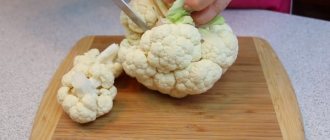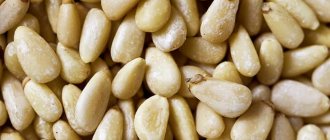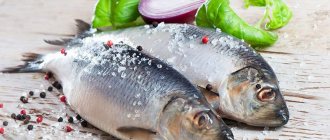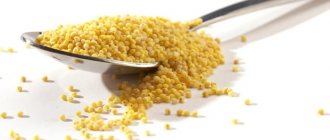A loving and caring mother tries to provide her newborn baby with the maximum influx of healthy vitamins and minerals. To do this, it is important to create a balanced and nutritious menu during breastfeeding. There are few acceptable foods that are included in the diet of a nursing woman, especially in the first days after the birth of the baby. The diet mainly uses cereals, fish and lean meats, and some vegetables. Oatmeal is a very healthy and nutritious cereal. This product is an indispensable component of many diets, including during lactation. Oatmeal is widely used in a woman’s diet when breastfeeding, but you must follow the recommendations for its consumption.
Composition and benefits of oatmeal
The healthy composition of porridge makes it a necessary component of almost any diet, so the question of whether oatmeal is ok for breastfeeding should not alarm a nursing woman. During breastfeeding, oat grains can be used uncrushed, rolled or in the form of flakes. However, during lactation it is not advisable to use instant cereals, since they may contain other additives.
Oatmeal contains a sufficient amount of important vitamins and microelements necessary to maintain the functioning of the body. These include vitamins (A, B1, B2, B3, B4, B5, B9, K, E), minerals (copper, iron, sodium, manganese, magnesium, calcium and others).
An important composition ensures the enormous benefits of oatmeal for the baby and his mother during breastfeeding.
The beneficial properties of oatmeal include:
- Improving the body's protective functions;
- Positive effect on heart function, preventing thrombosis and other vascular problems;
- Accelerates metabolism, has a positive effect on the functioning of the gastrointestinal tract, lowers cholesterol levels;
- Helps in the fight against constipation and increased acidity of gastric juice;
- Has a beneficial effect on the condition of the skin;
- Strengthens the skeletal system, teeth, improves hair condition;
- Has a calming effect during stress, nervous breakdowns, improves mood and memory;
- Ensures the formation of the correct blood composition and prevents the development of anemia.
In addition, the positive properties of oatmeal not only help improve the health of the newborn, but also improve lactation. Therefore, oatmeal should be a must-have product on a woman’s table when breastfeeding.
ethnoscience
There are also ways to improve lactation in folk recipes. So, a proven method for increasing the amount of milk is a mixture of cumin and sour cream. A pinch of spice is ground, poured with sour cream, left for an hour, then brought to a boil over low heat. Take a spoon three times a day.
Those who want to know how to enhance lactation can try mixing dill, anise and oregano in equal parts. Pour a tablespoon of the mixture into a glass of boiling water and drink a sip up to five times a day.

Traditional healers also advise how to improve lactation through walks in the fresh air, restful sleep and joyful time spent with the child. We restore lactation, mothers, the main thing is the health of the baby.
Now you know why breastfeeding is so important, how to increase the amount of milk and improve its quality. Good health to you and your baby, and if you can’t save milk, don’t despair. Use mixtures, but then give the baby more maternal warmth and love.

Every mother wants to give her child only the best. Nursing mothers are no exception, and when there is not enough milk in her breasts, this causes great concern and leads to stress. And stress, as you know, further aggravates this problem.
In addition to stress, milk supply is also affected by the mother's nutrition; everything you eat during this period is crucial for postpartum recovery and the lactation process. Food also affects the quality of the milk you feed your baby.
When can oatmeal harm the body?
Like any product, oatmeal can harm the body of the baby and mother during breastfeeding. This happens in exceptional cases, these include:
- Individual intolerance to gluten by mother or child;
- Heart failure;
- Kidney diseases;
- Allergy.
Important! Excessive consumption of oatmeal can provoke negative consequences for the body in the form of calcium leaching. This occurs due to the accumulation of phytic acid in the body.
GW principles
Every mother should remember the mandatory rules for improving lactation:
- after birth, no more than an hour should pass before breastfeeding;
- To increase lactation, proper nipple latching is of great importance;
- The main factor that increases milk production is applying the baby to the breast on demand.
Organizing a breastfeeding regime is still one of the main points of preparatory courses for future parents. You can’t organize milk flow by the clock. To improve lactation, you need to forget about stereotypes, stop constantly listening to caring new grandmothers and study new data from pediatricians in order to increase the amount of natural food.
Before you establish lactation, you need to understand that life has changed, and now the main thing in it is the little person who was born into the world. Believe me, he knows better than anyone when and how much to eat. Mom just needs to watch him and listen to her intuition. By the end of the first month of life, the milk supply should be exactly in the amount that the baby needs.
Often, due to cracked nipples, you have to bottle feed your baby. You should try to avoid this so that you don’t have to think about how to increase lactation later. The process of pumping and sucking a baby are very different from each other. And the main thing is that for nursing mothers, this communication with their part causes incredible sensations, and positive emotions are an important factor that increases lactation.
Which cereal should you choose?
For a woman who is breastfeeding, of course, the diet should include only natural products that retain all nutrients, without chemical additives. There are several types of porridges made from oat grains.
The most recommended and healthy is porridge made from whole grains. Oats that have ripened are only sifted, removing spoiled grains, and dried. This type of processing allows you to preserve all the vitamins and minerals in the finished product, thereby providing the body with complete saturation. The only drawback of this type of porridge is the cooking time. These grains are pre-soaked; the cooking time can reach 1-1.5 hours.
A simpler and more convenient way to prepare oatmeal is oatmeal. It only takes 10-15 minutes to cook them, and they retain many useful substances. Almost useless and undesirable are instant cereals, the so-called quick breakfasts. They are poured with boiling water and are ready to eat almost immediately. When pre-treated with steam, such oat flakes lose many of their beneficial microelements. In addition, manufacturers often add flavorings, flavor enhancers, preservatives and other components that are undesirable for a nursing woman to this type of porridge.

How to increase milk supply while breastfeeding?
The first thing you need to understand is that milk production depends on how often you put your baby to the breast. When a baby suckles at the breast, it irritates the nerve endings in the nipples and sends a signal to the brain that the baby needs some more milk. Therefore, if you feel that the baby does not have enough milk, put the baby to the breast more often. However, frequent breastfeeding may not help milk production if the mother's nutrition is very poor or completely incorrect. Therefore, the second thing you should pay attention to when breastfeeding your baby is the food you eat.
When to introduce oatmeal into the diet of a nursing mother?
When it comes to a balanced diet for a nursing mother in the first month of a baby’s life, we can absolutely say that it should include only healthy and non-allergenic foods. The answer to the question of whether a woman can have oatmeal immediately after the birth of her child is ambiguous. Some pediatricians advise starting to use the product after two months after birth, and some do not see any problems with using cereals in the first days of a baby’s life.
Each mother decides for herself when and with what to saturate breast milk in order to maximize the flow of nutrients into the child’s body. What is clear is that the amount of oatmeal at the first intake should be small (about 50 g) and it is advisable to take it in the first half of the day. If there are no adverse reactions, then you can then step by step (+ 50 g at a time) increase the portion of the dish to 200-250 g per day.
On the water
When consumed for the first time by a nursing woman, oatmeal should be cooked in water. It is easier to tolerate and is quickly absorbed by the newborn, and also eliminates the risk of an allergic reaction to lactose and cow protein. Oatmeal with water should be introduced into the diet after the baby becomes familiar with gluten-free cereals (rice, buckwheat, corn). This dish is a component of many diets (including breastfeeding), since it is low in calories, easily digestible and improves health.
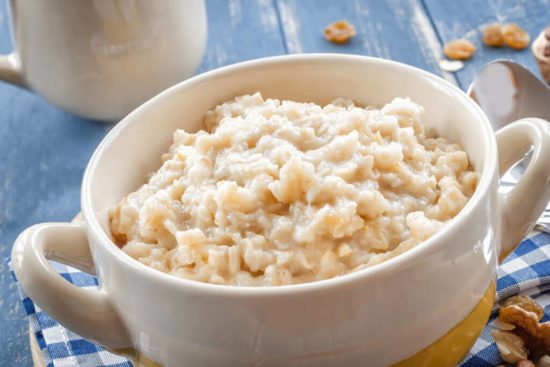
With milk
Oatmeal cooked with milk has more calories and keeps you full for a longer period. Complex carbohydrates, which are present in milk porridge, support the body with energy for several hours after consumption. A nursing woman should use this method of preparing a dish after trying porridge cooked in water. This will ensure that the wrong ingredient is quickly identified if an allergic reaction occurs.
Important! When consuming porridge with milk, you need to especially carefully monitor the newborn’s reaction, because Whole cow's milk in the mother's diet can cause colic and gas formation in the baby. If a child has lactase deficiency, milk should be excluded completely. Pediatricians recommend introducing milk into the menu 2-3 months after the baby is born.
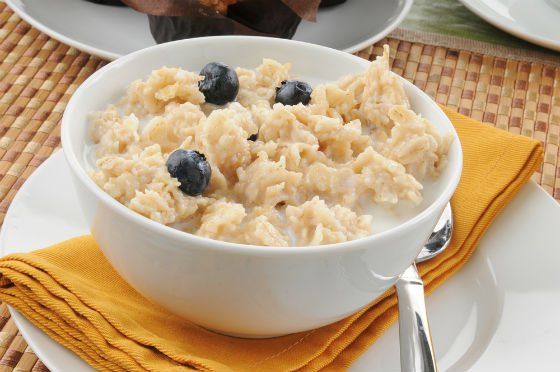
Natural or artificial?
A few years ago, there were no questions about breast milk as a way to feed a newborn. And in general, breastfeeding women had practically no problems. Today, some women, initially, not yet becoming pregnant, or only learning that they will soon become mothers, decide that they will feed with ready-made formulas.
No matter how high-quality it is, no matter how much it costs, there is no better food than mother’s formula milk. Of course, if the milk is gone, there is no other choice, but we must use every opportunity to increase and preserve the natural food for the newborn and organize proper feeding.
Even if a woman has very little milk, you should try to preserve it to the last drop, because only it contains the amino acids, proteins and albumins necessary for normal development, hormones, acids, etc. that ensure the normal development of the person born. Even the milk that disappears, mothers should try to save.
At the same time, a large volume of milk cannot always guarantee full supply, so every woman needs to know how to improve milk lactation.
Note! Scientists have proven that only 2.8% of modern women are not able to feed a baby on their own after childbirth; in all other cases, breast milk disappears either because of the desire of the mother herself, or because of her irresponsibility.
How to cook oatmeal correctly?
To prepare oatmeal, you just need to boil it (if using whole oat grains or flakes) or pour boiling water over it (if using instant oatmeal). In case of cooking, pour the required amount of porridge into boiling water or milk, stirring constantly. You need to cook it in salted water according to the instructions for 10 minutes to 1 hour (depending on the type of oatmeal). Once ready, add butter.
There are many recipes for oatmeal dishes, both salty and sweet. Various products are added to it, which change its taste and increase its nutritional value.
Delicious porridge recipes with the addition of other products
You can prepare breakfast with oatmeal by adding different products. It can be porridge with honey, fruit, jam. To diversify this dish with delicious sweets, just add them to the finished porridge and enjoy the new aroma and taste. But a woman who is breastfeeding should understand that not all fruits, especially honey and other sweets, can be beneficial for a newborn. This must be taken into account when selecting ingredients that the child is already accustomed to or those that cannot cause an allergy in him.
On a note! It is very healthy and tasty to add dried fruits (prunes or dried apricots) to porridge. First you need to pour boiling water over them and soak them a little so that the pieces become soft.
Oatmeal-based breakfasts don't have to be sweet. Oatmeal can serve as a side dish, to which you can add boiled lean meat, meatballs, fish, gravy, etc. Cookies or cutlets are also made from oatmeal.
Oatmeal is the main component of any diet, an essential source of vitamins during pregnancy, and also an important product during breastfeeding. It not only helps improve the health of mother and child, but also improves lactation. The main thing is to choose a quality product and be able to prepare it correctly. Only in this case will you get the maximum benefit from the finished dish.
Basic Tips
This is why pregnant women are advised to prepare their nipples for the upcoming event. Delicate skin will suffer from cracks and will be one of the reasons that will reduce lactation.
And also, you should not give your child water in the first months while supplementing his drinking. Even if a nursing mother has little milk, the newborn will help provide the necessary amount. At the same time, expressing it has not been recommended lately. It will be possible to increase the volume artificially, but whether the milk will be of high quality is unknown.
The best way to establish breastfeeding is to feed babies on demand. Just don't get carried away. If in the first months he asks for the breast only to eat, then over time, responding in this way to the slightest demand can only cause harm. Growing up, a child may call his mother not for food, but so that she can calm him down or simply give him some water. In such cases, there is no need to think about how to increase the amount of breast milk.
It is important for a woman to have time for proper rest. Sleep increases the production of a hormone that facilitates feeding. Rest at night is especially important, so both dad and grandmothers, who must replace the young mother at this time, are responsible for increasing lactation.
There is absolutely no need to be nervous. To increase lactation, a woman should lead a healthy and measured lifestyle and think less about everyday problems.
Thus, the following are harmful to lactation:
- mother's reluctance to feed;
- improperly organized lifestyle;
- basic ignorance of how to properly conduct breastfeeding;
- stress;
- illness, etc.
It is important! Even with a properly organized lifestyle after childbirth, mothers sometimes lose milk. This is called a lactation crisis and is considered almost the norm. Their occurrence is explained by changes in the baby’s needs. And the mother needs to know what to do and how to improve lactation, so as not to ruin everything by introducing artificial complementary foods.

Most often, when faced with a sharp decrease in milk, a woman thinks not how to improve lactation, but what to introduce instead of natural food. There is a feeling of guilt, there are worries, and all this is contraindicated for increasing lactation.
